Pharmacy Technicians’ Roles and Responsibilities in the Community Pharmacy Sector: A Welsh Perspective
Abstract
1. Introduction
1.1. Roles of Pharmacy Technicians
1.2. Aim
2. Materials and Methods
2.1. Overview of Study
2.2. Approvals and Ethical Considerations
2.3. Questionnaire
2.4. Interviews
2.5. Sampling, Recruitment and Study Procedures
2.6. Data Analysis
3. Results
3.1. Participant Characteristics
The smoking [training] certainly did [enable me to undertake the role effectively], because we’ve got a lot of patients on the program, so we do a lot of that in our area, which is good. I—it was just myself and the two pharmacists that—in our two stores and my—the pharmacist here is usually quite busy with other things. So, I tend to take the smoking cessation patients, which is fine with me, because I quite like the—being able to do that service, so—and the training was quite extensive and really in-depth. So, I was able to take that up from day one.
“Well with the independent [previous employer] I did the smoking with him, did that extra training, so I was certified for that”.
It’s lapsed. It’s lapsed, I just haven’t used it for so long working with the company I work for now, they just—you know most of the pharmacists kind of deal with that, so there are technicians that do do it in the company, but as for me it just never happened.
3.2. PT Roles
More responsibility and more respected as a team leader.(P83, large multiple, 2017)
As a PT have the knowledge to answer questions / queries from customers with confidence.(P75, large multiple, 2005)
The pharmacist starting delegating more responsible roles to me. The knowledge I gained was used more effectively and I was allowed to demonstrate how my competence had improved. I felt I was trusted with more responsibility, because I worked in a more professional manner.(P53, medium sized multiple, 2003)
More responsibility—more involvement in problem solving.(P40, small chain, 2004)
3.3. Perceived Barriers and Enablers
“Whilst interesting most of what I learnt for the NVQ 3 has never been used in my current position”.(P15, large multiple, 2002)
“The training was a base for a pharmacy tech, the skills needed are learnt through experience, it’s not an easy job to do and definitely needs in depth training to fully cover all aspects of the job role”.(P49, large multiple, 2011)
“Would have liked an on-site visit to assess my work, found the assessment was not portraying my work, instead of paperwork through my course”.(P46, independent pharmacy, 2012)
So the ACT dispense a lot less that what they used to, because we have people who dispense and then the ACTs do the checking. We—there’s a lot more of a defined role now. I mean, I think we could still be better and there’s still a lot we could do, but I think we’re definitely moving in the right direction.
Support of the superintendent pharmacist which enables me to lead and develop my team.(P6, independent pharmacy, 2009)
A strong supportive non-pharmacy manager plays a huge role in my pharmacy. Colleagues who work together in a very busy pharmacy.(P10, medium sized multiple, 2015)
My pharmacy manager gives me the encouragement and confidence for me to undertake my role effectively.(P38, large multiple, 2016)
Quality of training. The right person in the right task. Clean and efficient working environment. Good managerial team.(P66, large multiple, 2006)
I have continual trading [training] from my pharmacist to ensure I’m up to date with what I’m checking.(P73, medium size multiple, 2001)
We don’t have enough staff for me to do my job role. I am the only qualified technician in our dispensary.(P7, large multiple, 2016)
Enough staff to have more time to take on the roles I would like to do.(P36, large multiple, 2003)
The pressure of a very busy pharmacy sometimes means you don’t have enough time to interact with patients.(P9, large multiple, 1993)
Pharmacists having to take on too many services. Not enough time for them to do any prescription checking.(P58, large multiple, 2002)
Offering weight loss service and stop smoking device [service] in pharmacy, unable to at present as not undertaken relevant training yet.(P77, independent pharmacy, 2013)
More enhanced services, specifically DMR (discharge) and flu jabs. I see no reason why fully qualified technicians can’t learn and provide the service. Also we should be carrying out MURs in the home to the patients who need more assistance. Technicians should somehow be able to assist with that and be able to do the home visits and the medicines management.(P60, independent pharmacy, 2008)
There are lots of service roles that are aimed at pharmacists—no smoking, weight control etc. that both technicians or pharmacists could do but both are hampered by the continuous and increasing demands or repeat dispensing.(P56, independent pharmacy, 2009)
Checking prescriptions which I can no longer do due to the introduction on [of] advance dispensing and robot dispensing.(P55, large multiple, 2002)
Mentor staff when doing courses. I do this but only in a casual way. The pharmacist does this officially.(P45, independent pharmacy, 2001)
3.4. Relationship between Type of Pharmacy and Barriers and Enablers
4. Discussion
5. Recommendations and Conclusions
- Community pharmacy employers and stakeholders should recognise the potential of the CPT workforce and address the barriers to optimisation of the current CPT role in Wales.
- Community pharmacy employers and stakeholders should prioritise the training and development of CPTs and enable them to undertake extended roles, which will support the future delivery of pharmacy services in Wales.
- Following the introduction of the new IET standards and guidance on tutoring, the GPhC should explore the impact of the standards and guidance on the training experiences of PRPTs and the understanding of the IET requirements by the wider pharmacy team.
- Further qualitative research into the CPT workforce in Wales should include further exploration of time spent on specific roles, and the exploration of how professional identities are developed, as well as the views of pharmacists on issues such as the delegation and efficacy of IET.
Supplementary Materials
Author Contributions
Funding
Acknowledgments
Conflicts of Interest
References
- Welsh Government. A Healthier Wales: Our Plan for Health and Social Care. 2018. Available online: https://www.basw.co.uk/system/files/resources/180608healthier-wales-mainen.pdf (accessed on 4 March 2020).
- Welsh Government. Written Statement Community Pharmacy Funding 2017-18 and beyond. 2017. Available online: https://gov.wales/written-statement-community-pharmacy-funding-2017-18-and-beyond (accessed on 4 March 2020).
- Robinson, J. Diverging community pharmacy practice across the four UK nations. Pharm J. 2017, 299. [Google Scholar] [CrossRef]
- Welsh Government. Written Statement Delivering Prudent Healthcare within Wales. 2014. Available online: https://gov.wales/written-statement-delivering-prudent-healthcare-wales (accessed on 4 March 2020).
- General Pharmaceutical Council. Annual Report 2016-2017. 2018. Available online: https://www.pharmacyregulation.org/sites/default/files/gphc_annual_report_2016-17.pdf (accessed on 1 October 2018).
- General Pharmaceutical Council. Criteria for Registration as a Pharmacy Technician. 2013. Available online: https://www.pharmacyregulation.org/sites/default/files/Registration%20criteria%20for%20pharmacy%20technicians%20May%202013.pdf (accessed on 28 November 2019).
- Bradley, F.; Willia, S.C.; Noyce, P.R.; Schafheutle, E.I. Restructuring supervision and reconfiguration of skill mix in community pharmacy: Classification of perceived safety and risk. Res. Soc. Admin. Pharm. 2016, 12, 733–746. [Google Scholar] [CrossRef] [PubMed]
- General Pharmaceutical Council. Tomorrow’s Pharmacy Team, Future Standards for the Initial Education and Training of Pharmacists, Pharmacy Technicians and Pharmacy Support Staff. 2015. Available online: https://www.pharmacyregulation.org/sites/default/files/tomorrows_pharmacy_team_june_2015.pdf (accessed on 1 October 2018).
- John, C.; Brown, A. Technicians and other pharmacy support workforce cadres working with pharmacists: United Kingdom Case Study. Res. Soc. Admin. Pharm. 2017, 13, 297–299. [Google Scholar] [CrossRef] [PubMed]
- Howe, H.; Wilson, K. (2012) Modernising Pharmacy Careers Programme. Review of Post-Registration Career Development of Pharmacists and Pharmacy Technicians, Background Pape. 2012. Available online: http://docplayer.net/3056835-%C2%AD%E2%80%90Modernising-%C2%AD%E2%80%90pharmacy-%C2%AD%E2%80%90careers-%C2%AD%E2%80%90programme-%C2%AD%E2%80%90review-%C2%AD%E2%80%90of-%C2%AD%E2%80%90post-%C2%AD%E2%80%90registration-%C2%AD%E2%80%90career-%C2%AD%E2%80%90development-%C2%AD%E2%80%90of-%C2%AD%E2%80%90pharmacists-%C2%AD%E2%80%90and-%C2%AD%E2%80%90pharmacy-%C2%AD%E2%80%90technicians.html (accessed on 11 September 2018).
- Boughen, M.; Fenn, T.; Croot, J.; Frost, K.; Family, H.; Wright, D.; Sutton, J. Identifying the Roles of Pharmacy Technicians in the UK, Final Report, September 2016. Available online: https://www.uea.ac.uk/documents/899297/15294873/Identifying+The+Role+Of+Pharmacy+Technicians+In+The+UK/d6d60e7b-f527-481a-8f16-9f3f04037b6c (accessed on 1 October 2018).
- Schafheutle, E.I.; Jee, S.D.; Willis, S.C. The influence of learning environments on trainee pharmacy technicians’ education and training experiences. Res. Soc. Admin. Pharm. 2018, 14, 1020–1026. [Google Scholar] [CrossRef] [PubMed]
- Mattingly, A.N.; Mattingly, T.J. Advancing the role of the pharmacy technician: A systematic review. JAPhA 2018, 58, 94–108. [Google Scholar] [CrossRef] [PubMed]
- Desselle, S.P.; Hoh, R.; Holmes, E.R.; Gill, A.; Zamora, L. Pharmacy Technician self-efficacies: Insight to aid future education, staff development, and workforce planning. Res. Soc. Admin. Pharm. 2018, 14, 581–588. [Google Scholar] [CrossRef] [PubMed]
- Koehler, T.; Brown, A. A global picture of pharmacy technician and other pharmacy support workforce cadres. Res. Soc. Admin. Pharm. 2017, 13, 271–279. [Google Scholar] [CrossRef] [PubMed]
- Welsh Government. A Healthier Wales: Our Plan for Health and Social Care. 2019. Available online: https://gov.wales/sites/default/files/publications/2019-10/a-healthier-wales-action-plan.pdf (accessed on 2 March 2020).
- Bryman, A. Soc. Research Methods, 5th ed.; Oxford University Press: Oxford, UK, 2016. [Google Scholar]
- British Educational Research Association Ethical Guidelines for Educational Research. Available online: https://www.bera.ac.uk/wp-content/uploads/2014/02/BERA-Ethical-Guidelines-2011.pdf?noredirect=1 (accessed on 22 September 2018).
- Bowling, A. Quantitative Social Science: The survey. In Handbook of Health Research Methods; Bowling, A., Ebrahim, S., Eds.; Open University Press: Berkshire, UK, 2005. [Google Scholar]
- Rattray, J.; Jones, M.C. Essential elements of questionnaire design and development. J. Clin. Nurse 2007, 16, 234–243. [Google Scholar] [CrossRef] [PubMed]
- Miller, R.L.; Brewer, J.D. The A-Z of Soc. Research; SAGE Publications Ltd.: London, UK, 2007. [Google Scholar]
- Seston, L.; Hassell, K. Briefing Paper: GPhC Pharmacy Technician Register Analysis 2012. Available online: https://www.pharmacyregulation.org/sites/default/files/document/gphc-pharmacy-technician-register-analysis-2012.pdf (accessed on 1 October 2018).
- General Pharmaceutical Council. Registrant Survey 2013, Initial Analysis. 2014. Available online: https://www.pharmacyregulation.org/sites/default/files/gphc_registrant_survey_2013_initial_analysis.pdf (accessed on 4 July 2018).
- Cohen, L.; Manion, L.; Morrison, K. Research Methods in Education; Routledge: Abingdon, UK, 2011. [Google Scholar]
- General Pharmaceutical Council. Survey of Registered Pharmacy Professionals 2019. Available online: https://www.pharmacyregulation.org/sites/default/files/document/gphc-2019-survey-pharmacy-professionals-main-report-2019.pdf (accessed on 16 February 2018).
- Health Education and Improvement Wales (HEIW). (2020) Wales Community Workforce Survey Report 2019; Health Education and Improvement Wales (HEIW): Nantgarw, Wales; p. 50, (Unpublished report).
- Salameh, L.; Yeung, D.; Surkic, N.; Gregory, P.; Austin, Z. Facilitating integration of regulated pharmacy technicians into community pharmacy practice in Ontario: Results of an exploratory study. CPJ 2018, 151, 189–196. [Google Scholar] [CrossRef] [PubMed]
- Doucette, W.R.; Schommer, J.C. Pharmacy Technicians’ Willingness to Perform Emerging Tasks in Community Practice. Pharmacy 2018, 6. [Google Scholar] [CrossRef] [PubMed]
- Allan, M.; (Director, Wales Centre for Pharmacy Professional Education). Letter to: Community Pharmacy Wales. 1 leaf. Available online: http://www.cpwales.org.uk/getattachment/Services-and-commissioning/Workforce-Development/Pharmacy-Technician-training/PRPT-Letter-to-CPW-Aug18.pdf.aspx?lang=en-GB (accessed on 31 August 2018).
- General Pharmaceutical Council. Approved Pharmacy Technician Courses 2019. Available online: https://www.pharmacyregulation.org/education/pharmacy-technician/accredited-courses (accessed on 27 April 2020).
- General Pharmaceutical Council. Standards for the Initial Education and Training of Pharmacy Technicians. 2017. Available online: https://www.pharmacyregulation.org/sites/default/files/standards_for_the_initial_education_and_training_of_pharmacy_technicians_october_2017.pdf (accessed on 1 March 2020).
- General Pharmaceutical Council. Guidance on Tutoring and Supervising Pharmacy Professionals in Training. 2018. Available online: https://www.pharmacyregulation.org/sites/default/files/document/guidance_on_supervising_pharmacy_professionals_in_training_august_2018.pdf (accessed on 3 March 2020).
- Alderman, A.K.; Salem, B. Survey Research. Plast. Reconstr. Surg. 2010, 126. [Google Scholar] [CrossRef] [PubMed]
- O’Reilly-Shah, V.N. Factors influencing healthcare provider respondent fatigue answering a globally administered in-app survey. Peer J. 2017, 5, e3785. [Google Scholar] [CrossRef] [PubMed]
- Hughes, M. Interviewing. In Research Methods for Postgraduate; Greenfield, T., Ed.; Arnold: London, UK, 2002; pp. 209–217. [Google Scholar]
- Block, E.S.; Erskine, L. Interviewing by Telephone: Specific Considerations, Opportunities and Challenges. Int. J. Qual. Methods 2012, 11. [Google Scholar] [CrossRef]

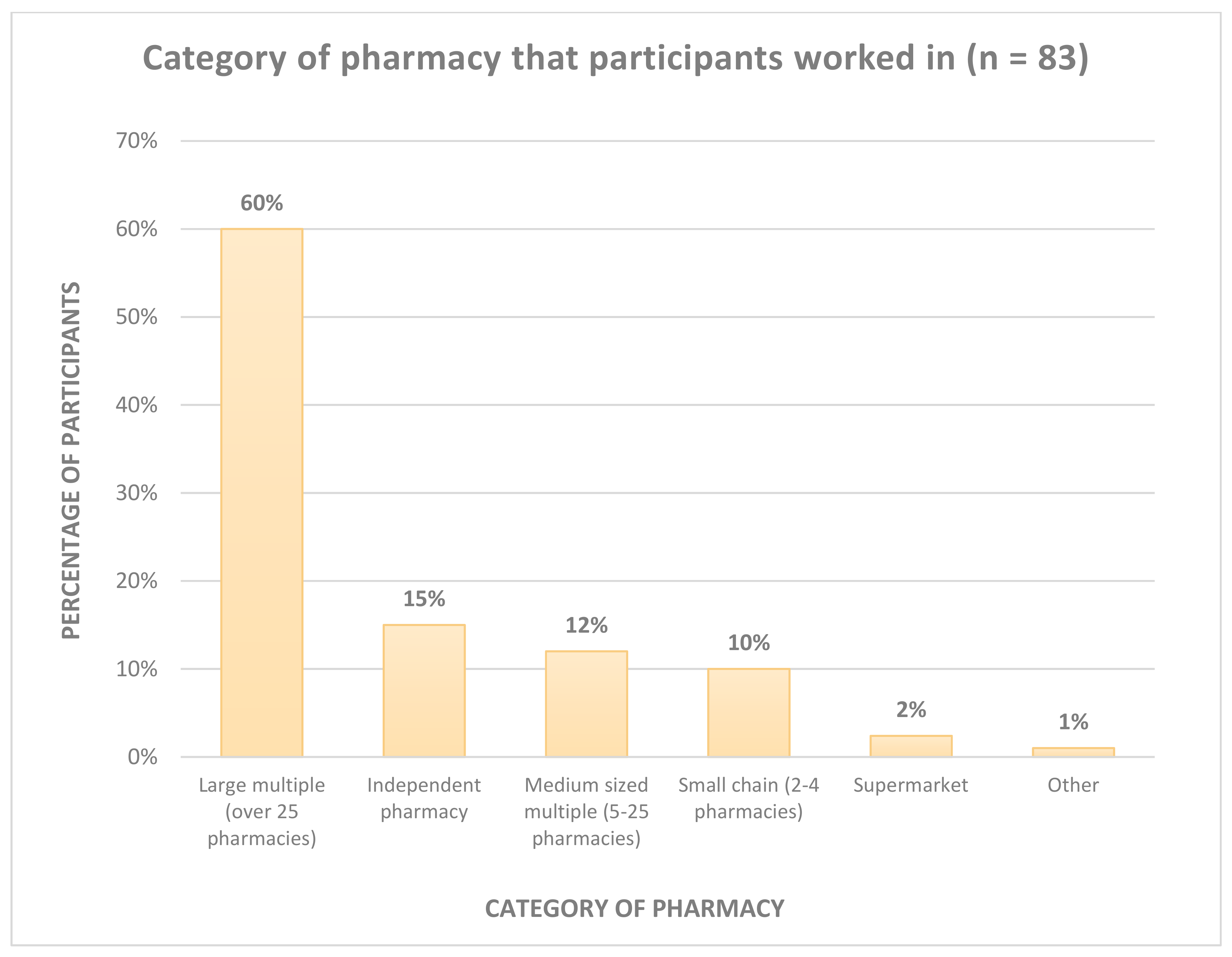
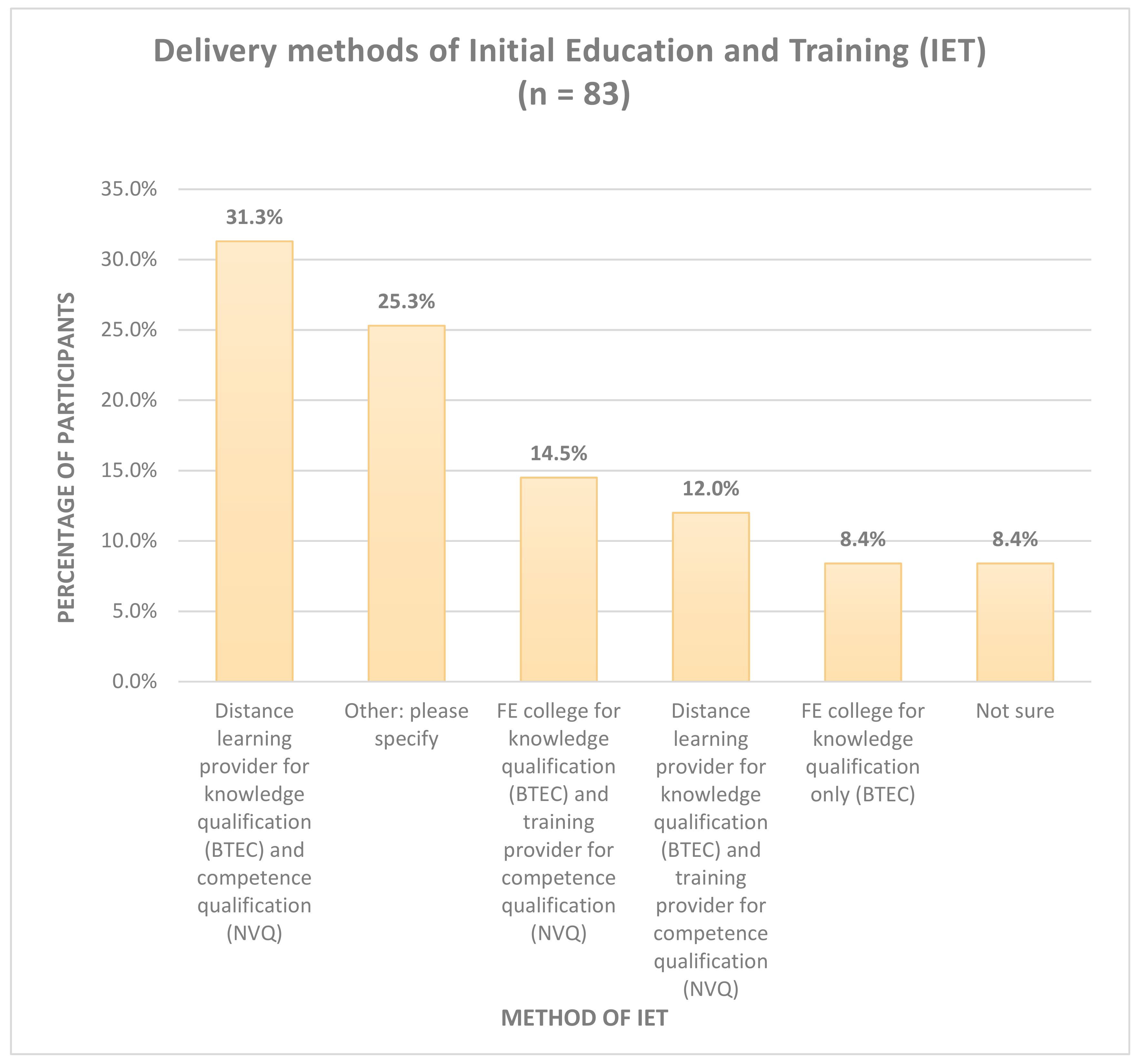
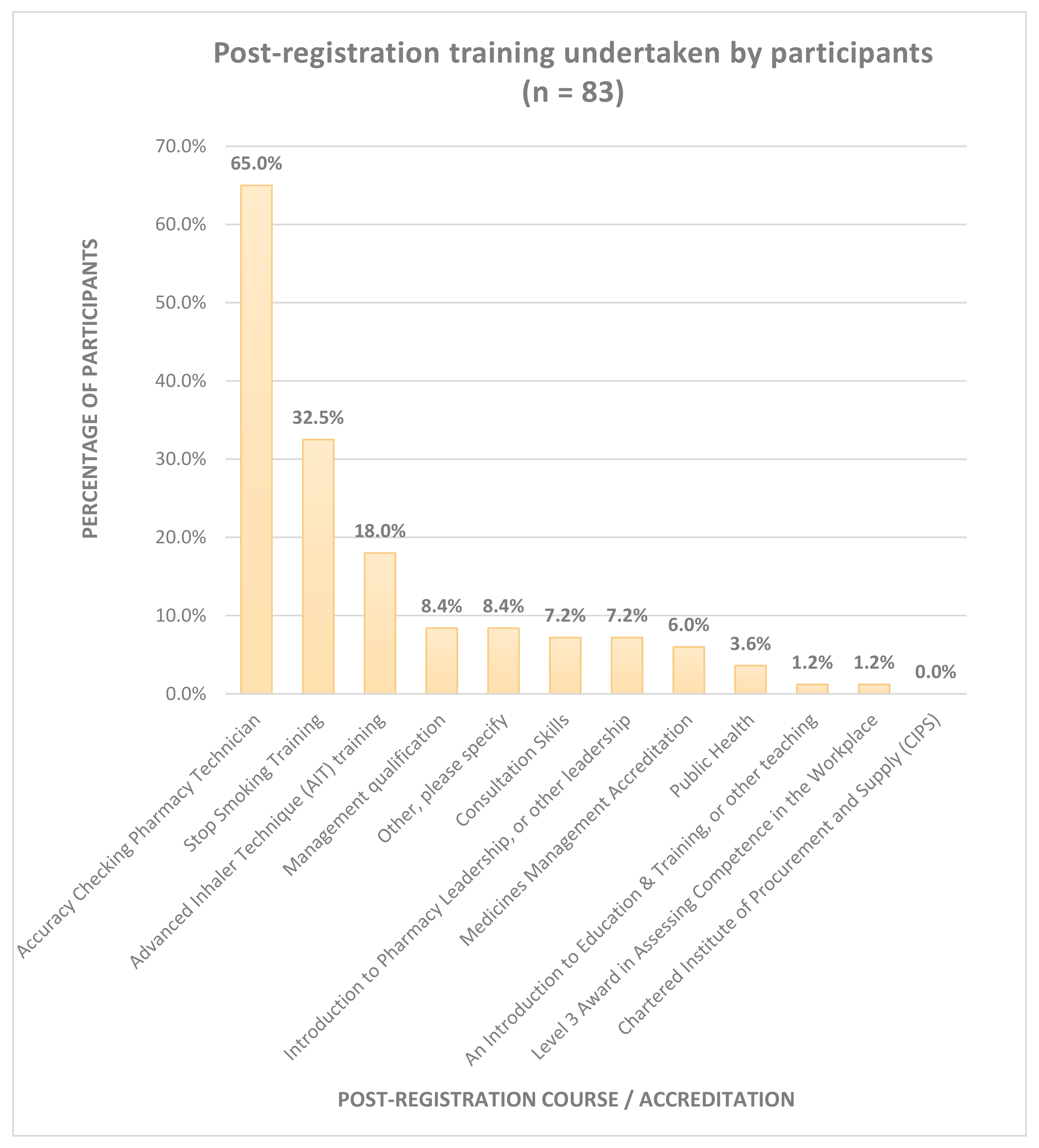

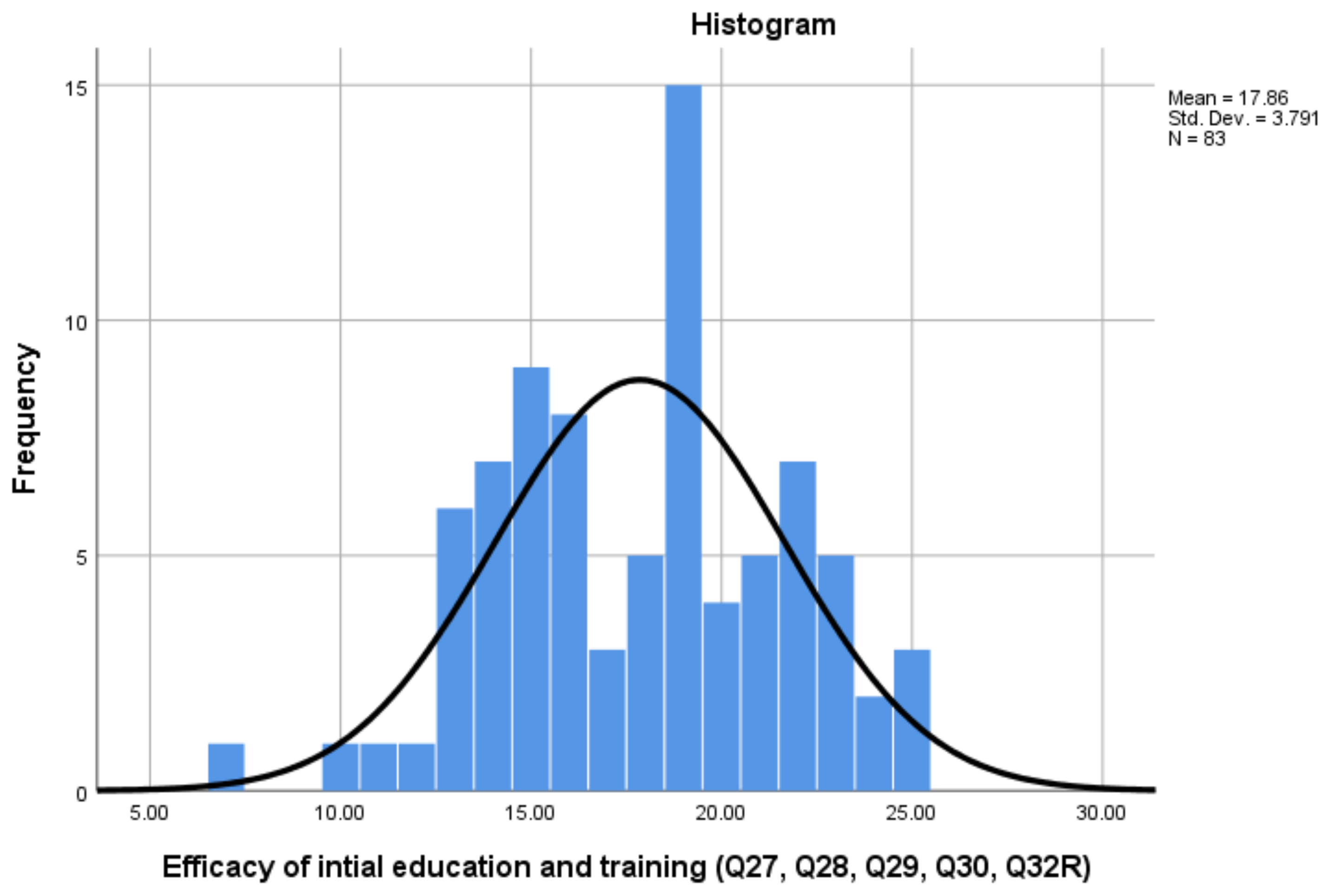
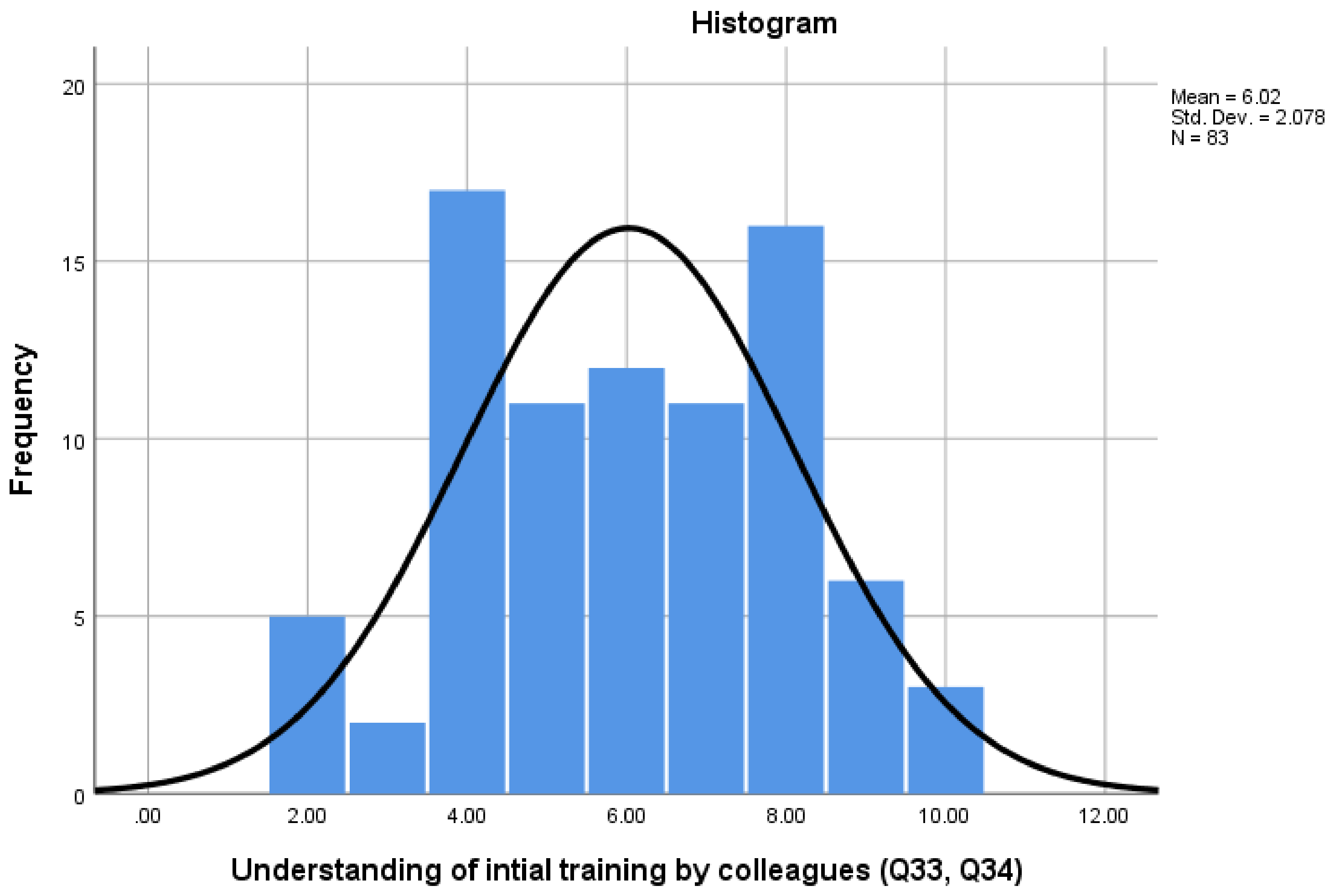
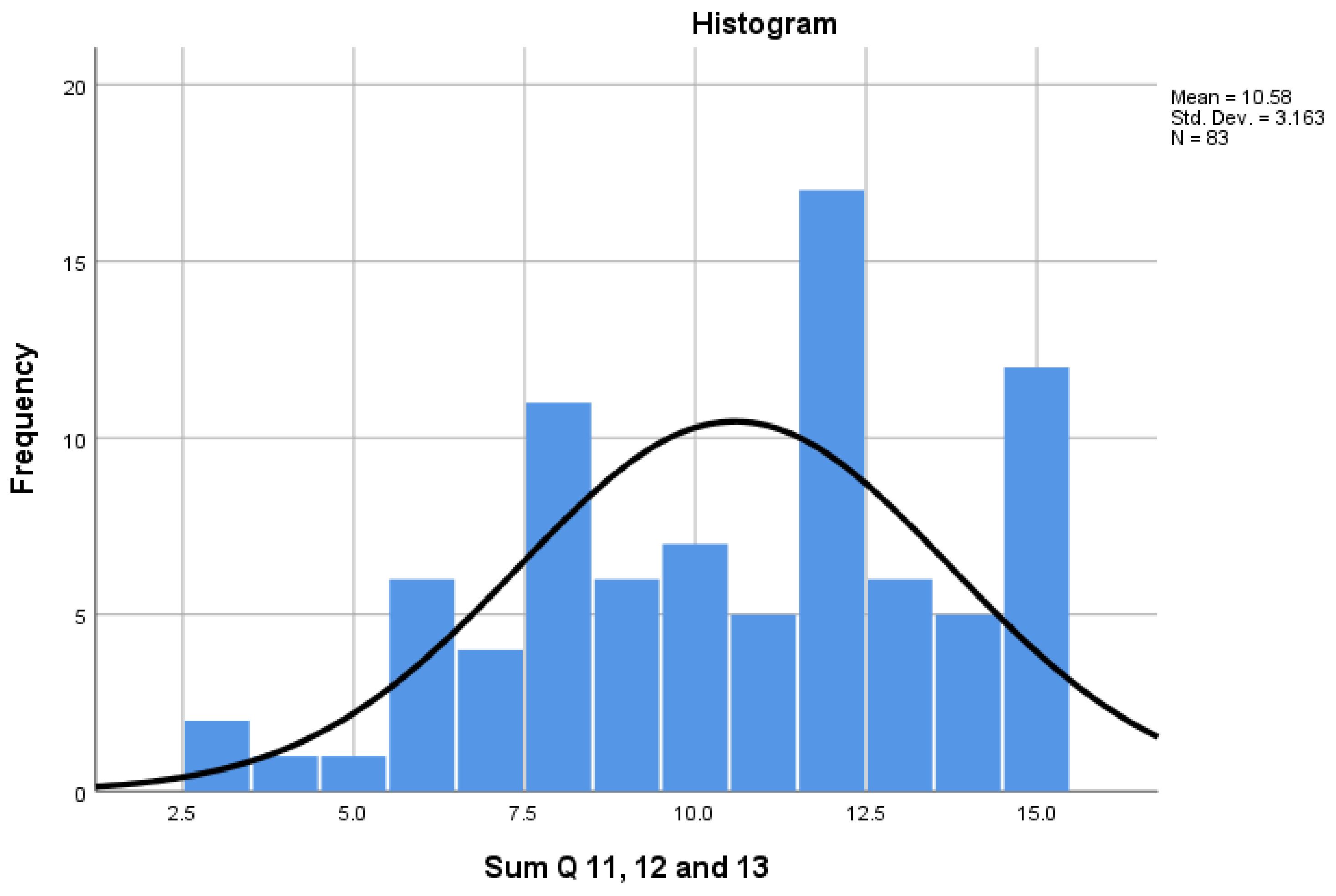
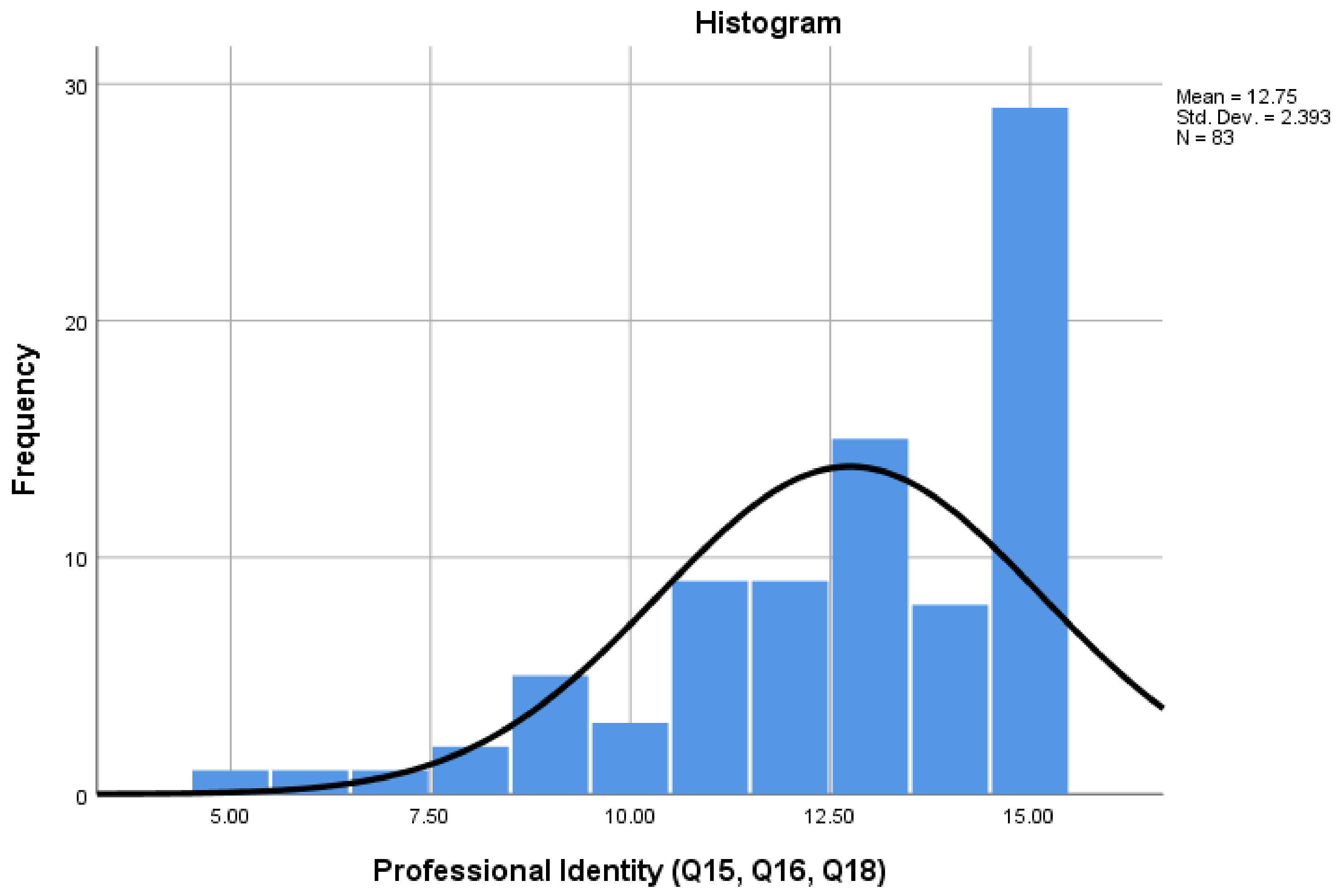

| Characteristic | Frequencies |
|---|---|
| Number of years qualified | Range 1 to 38; Mean = 13 (SD = 8.2) |
| Qualified pre mandatory registration in 2011 | n = 60 (69%) |
| Worked as a Dispenser prior to becoming a PT | n = 74 (89%) |
| Number of hours worked a week | Range 12 to 45; Mean 31.7 (SD = 7.84) |
| Scale | Number of Items | Cronbach’s Alpha | Scale Range | Scale Mid-Point | % above Scale Mid-Point |
|---|---|---|---|---|---|
| Efficacy of Initial Training | 5 | 0.775 | 7–25 | 15 | 68.7% |
| (scale 5 to 25) | |||||
| Colleagues Understanding of IET | 2 | 0.703 | 2–10 | 6 | 43.4% |
| (scale 2–10) | |||||
| Workplace Support | 3 | 0.663 | 3–15 | 9 | 72.7% |
| (scale 3–15) | |||||
| Professional Identity | 3 | 0.700 | 5–15 | 9 | 88.0% |
| (scale 3–15) | |||||
| Delegation | 2 | 0.666 | 2–10 | 6 | 68.7.% |
| (scale 2–10) |
© 2020 by the authors. Licensee MDPI, Basel, Switzerland. This article is an open access article distributed under the terms and conditions of the Creative Commons Attribution (CC BY) license (http://creativecommons.org/licenses/by/4.0/).
Share and Cite
Chamberlain, R.; Huyton, J.; James, D. Pharmacy Technicians’ Roles and Responsibilities in the Community Pharmacy Sector: A Welsh Perspective. Pharmacy 2020, 8, 97. https://doi.org/10.3390/pharmacy8020097
Chamberlain R, Huyton J, James D. Pharmacy Technicians’ Roles and Responsibilities in the Community Pharmacy Sector: A Welsh Perspective. Pharmacy. 2020; 8(2):97. https://doi.org/10.3390/pharmacy8020097
Chicago/Turabian StyleChamberlain, Rebecca, Jan Huyton, and Delyth James. 2020. "Pharmacy Technicians’ Roles and Responsibilities in the Community Pharmacy Sector: A Welsh Perspective" Pharmacy 8, no. 2: 97. https://doi.org/10.3390/pharmacy8020097
APA StyleChamberlain, R., Huyton, J., & James, D. (2020). Pharmacy Technicians’ Roles and Responsibilities in the Community Pharmacy Sector: A Welsh Perspective. Pharmacy, 8(2), 97. https://doi.org/10.3390/pharmacy8020097





